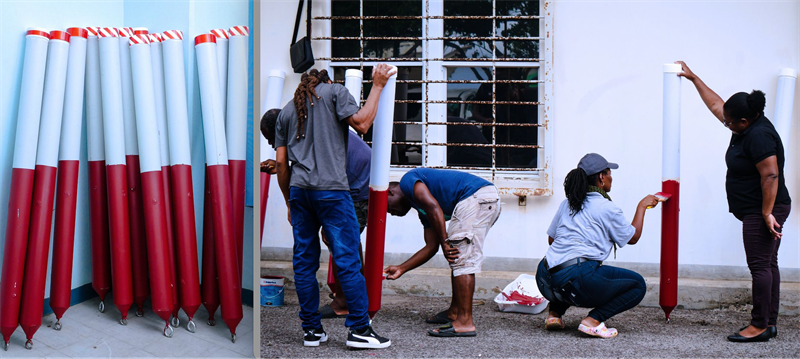NINE SEAMOSS FARMERS LEARNED TO CONSTRUCT BUOYS FROM LOCALLY-SOURCED MATERIALS.
 The Saint Lucia National Conservation Fund (SLUNCF) in collaboration with the Department of Fisheries conducted a 3-day buoy construction training which started on December 7th and ended on December 11th. This training was held at the Fisheries Satellite office in Vieux-Fort and was made possible through the BIOPAMA Rapid Response Grant project entitled “Enhancing the effective management of Savannes Bay within the Pointe Sable Environmental Protection Area (PSEPA) to support livelihoods and protect biodiversity”.
The Saint Lucia National Conservation Fund (SLUNCF) in collaboration with the Department of Fisheries conducted a 3-day buoy construction training which started on December 7th and ended on December 11th. This training was held at the Fisheries Satellite office in Vieux-Fort and was made possible through the BIOPAMA Rapid Response Grant project entitled “Enhancing the effective management of Savannes Bay within the Pointe Sable Environmental Protection Area (PSEPA) to support livelihoods and protect biodiversity”.
A total of nine (9) seamoss farmers had the opportunity to benefit from this training which aimed to equip them with the necessary skills and knowledge to construct buoys from locally sourced materials. At the end of the training the participants were able to fabricate 16 buoys. These devices will eventually be used for zoning and demarcation within Savannes Bay area as part of a suite measures intended to improve resource use within this ecologically important site. Mr Vaugn Serieux, Marine Biologist with the Department of Fisheries highlights the use of these devices as more affordable in terms of procurement and maintenance in the long run.
Savannes Bay falls within the PSEPA and encompasses a series of interconnected ecosystems such as mangroves, seagrass beds, coral reefs and an offshore island. These together support robust marine health and a range of associated livelihood activities, most notably fishing and seamoss farming.
In the last two years, the number of seamoss farms in the area has ballooned around the coastlines of Saint Lucia owing to the sharp increase in the demand and price of seamoss and its byproducts both locally and in foreign markets. The trend is no different in Savannes Bay but local authorities and stakeholders have expressed major concerns regarding the extent of seamoss farming in the area and the impact on the health of this vibrant marine space. Among other things, there are worries about the onset of irreversible effects on seagrass meadows as a result of constant trampling of the sea floor and the harvesting of round wood from fringing mangrove forests given the nature of how these farms are established. Additionally, fishermen, and other resource users and local officials have warned of potential conflict among competing resource use groups.
Therefore, there is a proposal under consideration to create zones within the area based on agreed considerations in order to lessen the potential of these negative impacts. In August, 2023, the SLUNCF along with other partners held two major consultations with interest groups such as fishers, seamoss farmers; eco-tourism, regulatory agencies and other important stakeholders in order to initiate discussions on the justification for zoning and as well to attempt to get critical input from these groups on how the zoning process can be achieved and under what conditions. Although this process is in the early stages, according to the CEO of SLUNCF, Mr Craig Henry, ‘the prospects look promising for reaching consensus on this measure given that project is taking the time to both inform and listen in order to increase the likelihood of success and cooperation’.
The Project seeks to enhance the management and governance of Savannes Bay’s natural resources through interventions that regulate and promote sustainable livelihoods through the sustainable use of resources via (1) mapping, zoning and demarcation of Savannes Bay; (2) certification and registration of sea moss farmers; and (3) creation of a framework for the establishment of a Sea moss Farmers’ Cooperative. 100 to 150 persons are expected to benefit from this Project including inter alia registered fishers, sea moss farmers, tour operators, subsistence or recreational fishers, recreational users, researchers and management staff.
Through this collaboration, the SLUNCF and the Fisheries Department intend on conducting similar training exercises to construct some additional buoys and have committed towards contributing to the effective management of natural resources and promoting sustainable practices for the benefit of all stakeholders involved.
For more information on this project please contact the Mr Craig Henry at ceo@sluncf.org.